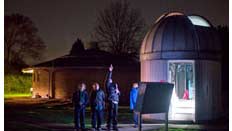Studying with us
Our observatory at Bayfordbury was built in 1969 as a teaching facility to support our Physics and Astrophysics undergraduate degrees.
Extensive facilities
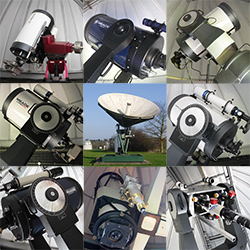 The University of Hertfordshire's observatory is one of the UK's largest and most extensive facilities for teaching observational astronomy.
The University of Hertfordshire's observatory is one of the UK's largest and most extensive facilities for teaching observational astronomy.
We have 8 high-quality metal domes - the most of any observatory in the UK - each housing at least one telescope. Many of the telescopes are similar and set up with similar cameras and filters. This allows us to keep group sizes smaller during observing practicals, ensuring everybody gets hands-on experience operating a telescope. Additionally, three of these telescopes can run robotically so we can maximise the amount of data we can capture on clear nights.
The first telescope to be built at Bayfordbury in 1969 is still in use, co-mounted with a more recently obtained 160 year-old refractor. It is the only telescope that is manoeuvered by hand, and is equipped with an eyepiece to provide stunning views of objects in the night sky. While it is not used for any of the observing practicals, we try to make time for students to use this telescope during their sessions at the observatory.
Course modules
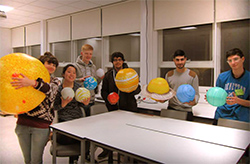 Physics and Astrophysics BSc and MPhys
Physics and Astrophysics BSc and MPhys
The Physical Universe (Level 4)
Within a few weeks of starting your degree you will be at Bayfordbury learning the basics of how to operate the telescopes and cameras. Two training sessions are followed by two further observing sessions, which have included taking colours pictures of galaxies and nebulae, and making a colour-magnitude diagram of stars.
Physics of the Solar System (Level 5)
Learn about the diverse range of solar system bodies and their dynamics, how planets form, their interiors/surfaces and ring systems, planetary and inter-planetary magnetic effects, and the possibilities for life elsewhere in the solar system. Observations of objects in our solar system are made with high-resolution video camera (moon and planets), along with measurements of the orbits of asteroids and comets.
Extra-Solar Planets (Level 5)
In the past three decades extra-solar planets have moved from science fiction to science-fact, with ground- and space-based surveys revealing several thousand extra-solar worlds. You will have the opportunity to use observations from Bayfordbury to detect these planets and make measurements of the planet and the star they are orbiting.
Star Formation and Evolution (Level 6)
The module will cover the fundamentals of stars and their structure, including their formation and evolution from the main sequence to final stellar remnants.
Foundations of Cosmology (Level 6)
The study of the structure and evolution of the Universe has in the last few decades undergone a true transformation. The module will cover the mathematical framework needed to describe expanding, curved space-time, and the concepts of Einstein’s General Theory of Relativity as it applies to cosmology.
Astrophysics Project and Investigative Skills (Level 6)
In the third year you will have the option to conduct your project at the Observatory if this is your area of interest.
You will carry out a piece of research and/or a literature review in a research topic. A successful project will become a feature of a student’s professional profile and CV, and is often a talking point in graduate job interviews and/or postgraduate applications.
Previous observatory projects include:
- Commissioning of a radio interferometer
- Construction of an Integral Field Unit
- Mapping the Orion Nebula
- Supernova searches
- Commissioning of an infrared telescope camera
- Modelling the Tunguska event
- Commissioning of an All-sky camera
High Energy Astrophysics (Level 7)
Measurements of galactic and extragalactic sources using the Observatory's radio telescopes give hands-on experience with radio astronomy, including the use of the UK's largest teaching interferometer.
Unrivalled access
With more telescopes than any other UK teaching observatory, our students are able gain the best hands-on experience. Your first visit to Bayfordbury begins within a few weeks of starting your degree, and a number of module choices allow observing practicals in every level of the degree. Practical group sizes are typically 2-3 people per telescope, allowing everyone a chance to take control of observatory equipment.
Outside of practicals, our three robotic telescopes allow observations to be scheduled remotely for automated observations. These can be used for both course-related and personal projects. The dynamic queuing system allows for everything from astrophotography to final-year research projects that might require hundreds of observations over a period of weeks or months.
Rural location
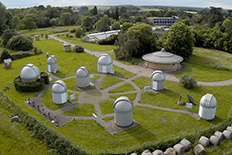
Whilst many university observatories are located on the main campus within a large town or city, Bayfordbury campus is in a rural location, offering darker and steadier views of the universe.
Bayfordbury is 6 miles from the main campus in Hatfield, allowing all of the benefits of a darker, countryside location, but being just a short 15 minute drive away. For observing practicals, transportation is provided from the College Lane campus in Hatfield.
Outreach programme
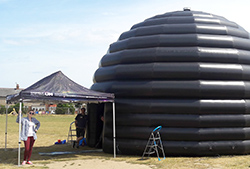 From the Department of Physics, Mathematics and Astronomy we run an extensive outreach programme to spread our passion with the public both locally and further afield. Our outreach events are run predominantly by undergraduate and postgraduate students who are paid to work part-time alongside their studies. At the Observatory we run monthly open evenings between October and March, along with private visits from groups of all ages.
From the Department of Physics, Mathematics and Astronomy we run an extensive outreach programme to spread our passion with the public both locally and further afield. Our outreach events are run predominantly by undergraduate and postgraduate students who are paid to work part-time alongside their studies. At the Observatory we run monthly open evenings between October and March, along with private visits from groups of all ages.
We have three planetariums: a small fixed planetarium inside the Science Building at Bayfordbury, and two larger mobile inflatable planetariums.
